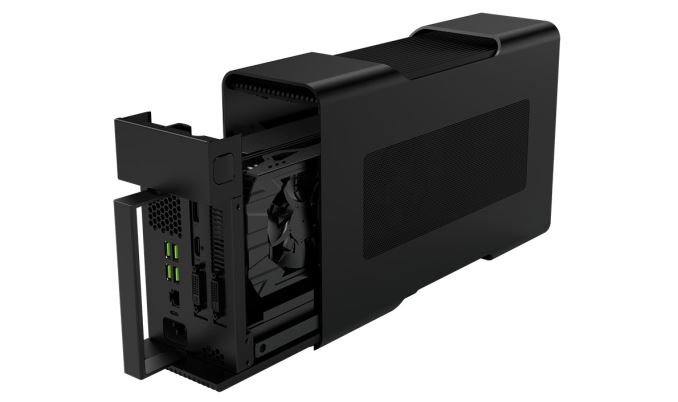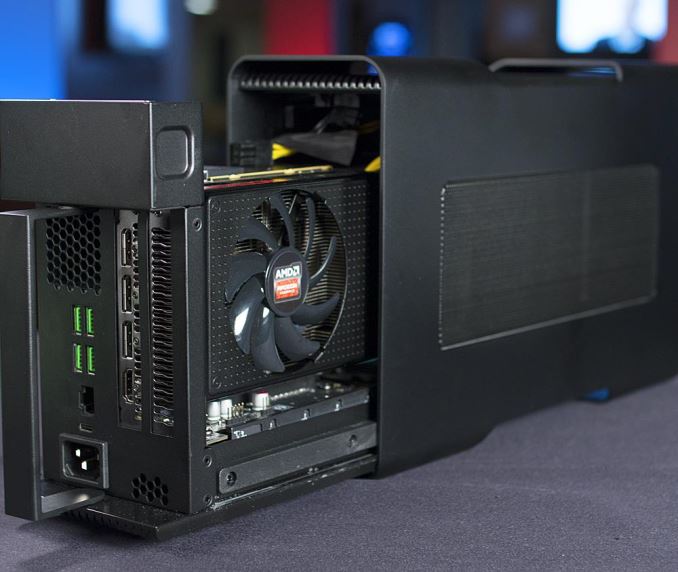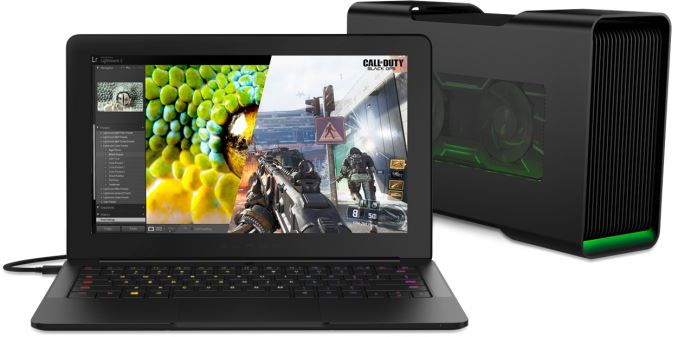Razer Core Thunderbolt 3 eGFX Chassis: $499/$399, AMD & NVIDIA, Shipping In April
by Ryan Smith on March 16, 2016 9:00 PM EST- Posted in
- GPUs
- Thunderbolt
- Razer
- Thunderbolt 3
- eGFX

Back at CES 2016, Razer announced their Core Thunderbolt 3 external graphics (eGFX) chassis. Built around the new Thunderbolt 3 standard and its long-awaited official support for external video cards, the Razer Core is the first eGFX chassis to hit the market. We got a bit more information about it with last week’s AMD XConnect announcement, and now today at GDC Razer is releasing the full details on functionality, compatibility, and availability.
Jumping right into things, the Razer Core is what can be considered a full size eGFX chassis. The unit is large enough to accommodate a double-wide video card up to 12.2 inches long, which covers almost every video card on the market. The only notable exceptions here are cards that use external radiators (e.g. Radeon R9 Fury X) and the small number of ultra-high-end triple-wide card designs such as some of MSI’s Lightning cards. The toolless design is able to handle both open air and blower type video card coolers, however given its smaller size relative to a full PC case, I think it’s going to be worth looking into just how well open air cards do.
| Razer Core Thunderbolt 3 eGFX Chassis Specifications | |||
| Max Video Card Size | Double-Wide, 12.2" Long (310 x 152 x 44mm) |
||
| Max Video Card Power | 375W | ||
| Connectivity | 4x USB 3.0 1x Gigabit Ethernet Laptop Charging via Thunderbolt 3 |
||
| Chassis Size | 4.13 x 13.9 x 8.66 inches (105 x 353 x 220mm) |
||
| Internal PSU | 500W | ||
| System Requirements | Thunderbolt 3 eGFX Certified PC Thundebolt 3 w/Active Cable Windows 10 |
||
| Shipping Date | April 2016 | ||
| Price | $499 ($399 w/Razer laptop) | ||
The chassis itself measures 4.13” x 13.9” x 8.66” and contains an internal 500W PSU, with Razer rating it to drive up to a 375W video card. At 10.89lbs it is technically portable, though clearly not ideal for the task given its handle-less design. Rather Razer intends this to be a fixed docking station for laptop users, as demonstrated both by the additional ports made available on the Core – 4x USB 3.0 Type-A and a gigabit Ethernet port – and by the fact that it’s capable of charging laptops over its Thunderbolt 3 connection.
The Core is the first of what we expect will be several TB3 eGFX chassis. As we briefly mentioned in our AMD XConnect overview, the Core is essentially the pathfinder product for the TB3 eGFX standard, with Intel, AMD, and Razer working together to put together the first devices and validate them. Consequently the Core is so far only validated to work with two laptops – Razer’s Blade Stealth and new 2016 Blade – however it should work with any future laptops that are also eGFX certified.
As for video card compatibility, while the Core was initially developed with Intel and AMD, Razer has confirmed that the chassis does support both AMD and NVIDIA video cards. The full compatibility list is posted below, but for AMD cards it’s essentially all of their latest generation (290 series and newer) video cards. Meanwhile on the NVIDIA side all of the company’s Maxwell 1 and Maxwell 2 cards are supported, starting with the GTX 750 Ti. Though given the price of the Core, it goes without saying that the expectation is that it will be paired up with high-end video cards as opposed to lower-end models.
| Razer Core Video Card Compatibility List | |||
| AMD | NVIDIA | ||
| Radeon R9 Fury | GeForce GTX Titan X | ||
| Radeon R9 Nano | GeForce GTX 980 Ti | ||
| Radeon R9 300 Series | GeForce GTX 980 | ||
| Radeon R9 290X | GeForce GTX 970 | ||
| Radeon R9 290 | GeForce GTX 960 | ||
| Radeon R9 280 | GeForce GTX 950 | ||
| GeForce GTX 750 Ti | |||
While the Core supports both AMD and NVIDIA cards, how well each brand is supported is looking a bit hazy. As part of the eGFX development cycle, AMD’s drivers are fully capable of and validated for eGFX plug ‘n play operation, allowing Windows to gracefully handle losing the external GPU with both planned and accidental disconnects. In the case of an accidental disconnect, Windows will stay up, while applications using the GPU may crash. However NVIDIA’s drivers have not yet been validated for plug ‘n play operation, and it sounds like at this moment NVIDIA is still hammering out the final bugs. That said, NVIDIA has committed to having drivers ready by the time the Core ships in April, so we'll have to see where things stand next month.
Finally, let’s talk about availability and pricing. Razer will begin taking pre-orders for the Core tonight through their website, with the chassis set to ship in April. As for pricing, the first eGFX chassis on the market will not come cheap: Razer is setting the base price on the chassis at $499, and after the cost of a high-end video card to put in the Core, we’re looking at a total price tag of $1000 or more. However Razer is offering a $100 discount on the Core if it’s purchased alongside a Razer Blade or Blade Stealth laptop – bearing in mind that these are the only two laptops eGFX certified at this time in the first place – which brings the effective cost down to $399. Razer also notes that this offer is also retroactive for customers whom already purchased a Blade Stealth earlier this year, as the ultrabook and the Core were announced together at CES and the company doesn’t want to penalize early buyers who were intending to grab the Core anyhow.


















80 Comments
View All Comments
TEAMSWITCHER - Thursday, March 17, 2016 - link
Google "Dropbox".JoeTF2 - Monday, March 21, 2016 - link
Google "idiot".How is Dropbox (and Dropbox - of all the file sync/storage solutions... that one company that till recently could only sync single folder with no versioning and strong encryption...) going to sync all my applications, all my application settings all my live data and hundreds of G of cold data?
Also, and I'm really curious to hear your answer, how is that of any use, since most prevalent use case for syncing between desktop and laptop is travelling?
How am I supposed to sync anything, when I'm on roaming, or local sim card that offers 500-4GB of data? Or on crappy wifi in the hotel?
Even for the cold data, even if it works, usability of instand access vs stremaing is so much better...
nerd1 - Thursday, March 17, 2016 - link
I paid $830 for a refurbished XPS 15.And nowadays you can easily secure terrabytes of cloud storage.
JoeTF2 - Monday, March 21, 2016 - link
Cool, so we are now comparing refurbished crap (it was returned and refurbished for a reason, you know...) vs. brand new high end laptop?Also, where can I secure 2TB of online storage, for the period of 3 years (typical timeframe for hdd replacement)? Can you factor the cost of this in the calculation?
Gastec - Sunday, September 4, 2016 - link
Trey the NSA :)TerminatorUK - Friday, April 8, 2016 - link
Hmm I'm suprised (unless I'm the only one thinking it) that no one has considered this use case:- You want to maximise your investment in your existing desktop gaming rig
- You like the idea of a gaming laptop too but would use it too infrequently (only occasional travel) to justify the high cost
- A high end gaming laptop is generally not upgradable (or has a limited scope for upgrading - especially GFX)
- Every few years, you would have to stick down £1500 ish for a good gaming laptop and find a good home for your 'old' one (or suffer being behind the curve in your hardware and have to play latest games at reduced settings)
- You could instead buy a cheap(ish) laptop of your choice in the future with a TB3 connection on it
- Buy the Razer Core
- Use the laptop 'normally' for day to day tasks (e-mail, browsing etc)
- When you are going away for a time and wish you had access to you PC, simply disconnect your desktop's GFX card and pop it in the core then take this along with you with your laptop
- Everytime up upgrade your desktop's GFX from now on, you are effectively upgrading your laptop too at no additional cost
- Lookjng to the future, DX12 games will be no longer as CPU limited so having an average laptop CPU will not be a major handicap
Over time, the enclosure 'pays for itself' as you don't need a whole new gaming laptop when you want to upgrade and upgrades you have brought for your desktop also benefit the laptop too.
RustyBusty - Thursday, March 17, 2016 - link
The blade stealth costs $999, on sale maybe hits $900 easy. For 1000 yards u can build a great gaming pcfrostyfiredude - Thursday, March 17, 2016 - link
But when on sale the Stealth included in the Stealth+Core cost will go down too. Too keep it comparable both or neither should be sale price.Basically, if you want an ultrabook and a gaming computer the tossup here is: 400$ Core + GPU or whole desktop computer. After considering OEM Win10, you're not building much of a gaming computer for 300$ + GPU. So for an existing Ultrabook w/TB3 owner this box just makes financial sense.
JoeTF2 - Monday, March 21, 2016 - link
Sorry, but a fucking gaming grade monitor will cost 500$. Assuming you don't want the recent 27' gaming grade displays form Acer or Asus, which will cost you 800-1000$.I mean, even decent gaming chassis costs 200-300$).
nerd1 - Friday, March 18, 2016 - link
Blade stealth is just a ultrabook with rather small screen (12.5") and bad battery life (due to 45Wh battery). Great gaming PC? Seriously?